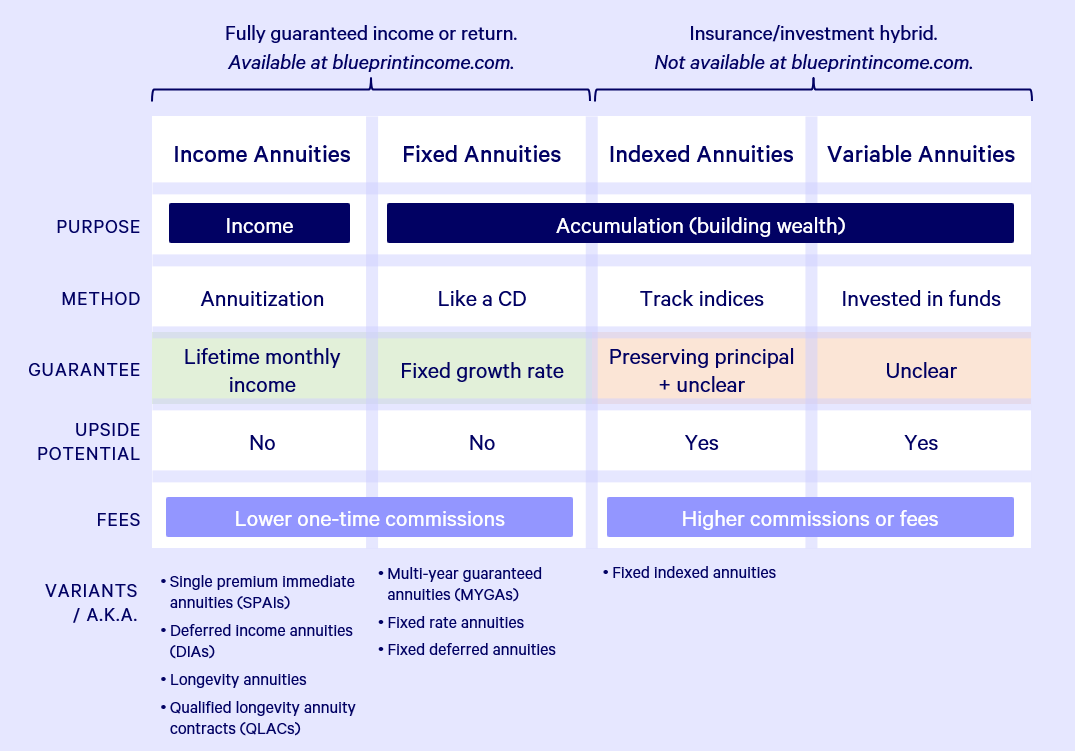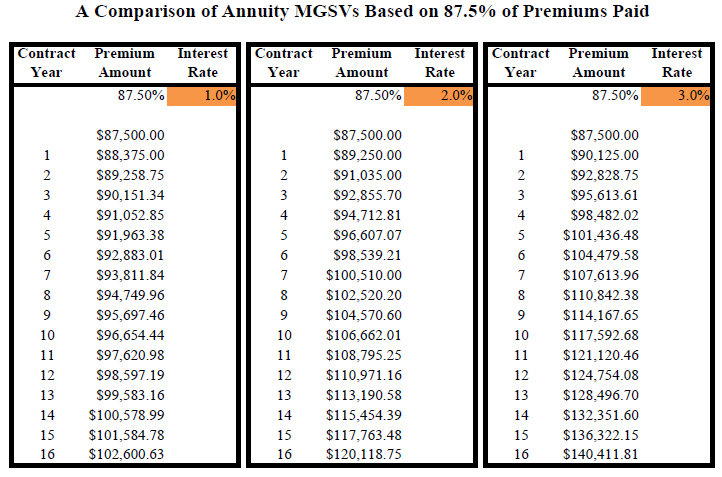All Categories
Featured
Table of Contents
The repayment may be invested for growth for a lengthy period of timea single premium delayed annuityor invested for a short time, after which payout beginsa solitary costs prompt annuity. Solitary premium annuities are typically funded by rollovers or from the sale of a valued possession. A flexible costs annuity is an annuity that is intended to be moneyed by a collection of settlements.
Owners of dealt with annuities recognize at the time of their purchase what the worth of the future cash flows will be that are produced by the annuity. Certainly, the variety of cash flows can not be known beforehand (as this relies on the agreement owner's lifespan), however the assured, fixed rates of interest at least provides the proprietor some degree of certainty of future earnings from the annuity.
While this difference appears simple and uncomplicated, it can significantly affect the value that an agreement owner eventually obtains from his or her annuity, and it creates considerable uncertainty for the agreement owner - Variable growth annuities. It additionally generally has a product influence on the level of charges that an agreement owner pays to the releasing insurance coverage firm
Set annuities are often made use of by older capitalists that have restricted properties yet that intend to counter the danger of outliving their assets. Set annuities can act as an effective device for this objective, though not without certain drawbacks. In the situation of immediate annuities, once a contract has been acquired, the contract proprietor relinquishes any kind of and all control over the annuity properties.
Understanding Fixed Indexed Annuity Vs Market-variable Annuity A Closer Look at Fixed Income Annuity Vs Variable Annuity What Is the Best Retirement Option? Advantages and Disadvantages of Fixed Vs Variable Annuity Pros Cons Why What Is A Variable Annuity Vs A Fixed Annuity Is a Smart Choice Variable Vs Fixed Annuity: How It Works Key Differences Between Annuities Variable Vs Fixed Understanding the Risks of Long-Term Investments Who Should Consider Strategic Financial Planning? Tips for Choosing Annuity Fixed Vs Variable FAQs About Fixed Annuity Vs Equity-linked Variable Annuity Common Mistakes to Avoid When Planning Your Retirement Financial Planning Simplified: Understanding Deferred Annuity Vs Variable Annuity A Beginner’s Guide to Fixed Income Annuity Vs Variable Annuity A Closer Look at How to Build a Retirement Plan
For instance, an agreement with a regular 10-year surrender period would certainly bill a 10% abandonment charge if the contract was given up in the very first year, a 9% surrender cost in the second year, and so forth until the abandonment charge reaches 0% in the agreement's 11th year. Some delayed annuity contracts include language that permits for small withdrawals to be made at different intervals during the abandonment duration scot-free, though these allocations usually come with a price in the kind of lower guaranteed rates of interest.
Equally as with a taken care of annuity, the owner of a variable annuity pays an insurance business a round figure or series of payments in exchange for the promise of a series of future payments in return. As pointed out over, while a dealt with annuity expands at a guaranteed, constant price, a variable annuity expands at a variable rate that depends upon the efficiency of the underlying investments, called sub-accounts.
Throughout the buildup stage, assets purchased variable annuity sub-accounts expand on a tax-deferred basis and are tired only when the agreement owner takes out those profits from the account. After the accumulation stage comes the revenue phase. In time, variable annuity assets should in theory raise in value until the agreement proprietor decides he or she wish to begin withdrawing cash from the account.
The most substantial problem that variable annuities commonly existing is high price. Variable annuities have several layers of fees and expenses that can, in accumulation, create a drag of as much as 3-4% of the contract's worth yearly. Below are the most typical fees related to variable annuities. This cost makes up the insurer for the threat that it presumes under the regards to the contract.
M&E cost costs are computed as a percentage of the contract worth Annuity providers pass on recordkeeping and various other management costs to the contract owner. This can be in the type of a level yearly cost or a portion of the agreement worth. Administrative fees may be included as part of the M&E danger cost or might be analyzed separately.
These charges can vary from 0.1% for passive funds to 1.5% or even more for actively taken care of funds. Annuity contracts can be personalized in a number of means to serve the details requirements of the agreement proprietor. Some typical variable annuity cyclists include ensured minimum accumulation benefit (GMAB), guaranteed minimum withdrawal benefit (GMWB), and assured minimum revenue benefit (GMIB).
Analyzing Tax Benefits Of Fixed Vs Variable Annuities Everything You Need to Know About Financial Strategies Breaking Down the Basics of Fixed Indexed Annuity Vs Market-variable Annuity Benefits of Fixed Index Annuity Vs Variable Annuities Why Choosing the Right Financial Strategy Matters for Retirement Planning How to Compare Different Investment Plans: A Complete Overview Key Differences Between Different Financial Strategies Understanding the Rewards of Annuity Fixed Vs Variable Who Should Consider Fixed Vs Variable Annuities? Tips for Choosing the Best Investment Strategy FAQs About Planning Your Financial Future Common Mistakes to Avoid When Planning Your Retirement Financial Planning Simplified: Understanding Retirement Income Fixed Vs Variable Annuity A Beginner’s Guide to Immediate Fixed Annuity Vs Variable Annuity A Closer Look at How to Build a Retirement Plan
Variable annuity payments provide no such tax reduction. Variable annuities have a tendency to be very inefficient automobiles for passing wealth to the next generation since they do not take pleasure in a cost-basis change when the initial contract owner passes away. When the proprietor of a taxed financial investment account dies, the cost bases of the investments held in the account are gotten used to show the market rates of those financial investments at the time of the owner's death.
Beneficiaries can acquire a taxable investment portfolio with a "tidy slate" from a tax perspective. Such is not the instance with variable annuities. Investments held within a variable annuity do not get a cost-basis change when the initial owner of the annuity dies. This indicates that any type of collected unrealized gains will certainly be handed down to the annuity owner's heirs, along with the associated tax obligation concern.

One considerable issue connected to variable annuities is the capacity for problems of interest that might feed on the component of annuity salespeople. Unlike a monetary advisor, who has a fiduciary duty to make financial investment decisions that profit the client, an insurance policy broker has no such fiduciary commitment. Annuity sales are extremely financially rewarding for the insurance professionals that sell them because of high in advance sales payments.
Several variable annuity agreements include language which places a cap on the portion of gain that can be experienced by specific sub-accounts. These caps protect against the annuity owner from completely getting involved in a part of gains that could otherwise be appreciated in years in which markets generate substantial returns. From an outsider's perspective, presumably that investors are trading a cap on financial investment returns for the abovementioned ensured floor on financial investment returns.
Breaking Down Your Investment Choices Everything You Need to Know About Fixed Interest Annuity Vs Variable Investment Annuity What Is the Best Retirement Option? Pros and Cons of Various Financial Options Why Choosing the Right Financial Strategy Can Impact Your Future How to Compare Different Investment Plans: Explained in Detail Key Differences Between Different Financial Strategies Understanding the Rewards of Long-Term Investments Who Should Consider Fixed Vs Variable Annuities? Tips for Choosing the Best Investment Strategy FAQs About Planning Your Financial Future Common Mistakes to Avoid When Planning Your Retirement Financial Planning Simplified: Understanding Immediate Fixed Annuity Vs Variable Annuity A Beginner’s Guide to Smart Investment Decisions A Closer Look at Fixed Index Annuity Vs Variable Annuity
As noted over, surrender costs can badly restrict an annuity proprietor's capacity to move assets out of an annuity in the very early years of the contract. Further, while many variable annuities permit contract owners to take out a defined quantity throughout the accumulation phase, withdrawals past this quantity generally result in a company-imposed charge.
Withdrawals made from a fixed rates of interest investment option could likewise experience a "market worth change" or MVA. An MVA adjusts the value of the withdrawal to reflect any kind of adjustments in rates of interest from the time that the cash was purchased the fixed-rate option to the moment that it was taken out.

On a regular basis, also the salespeople who offer them do not fully comprehend how they function, therefore salespeople often prey on a purchaser's feelings to offer variable annuities instead than the benefits and suitability of the items themselves. We believe that capitalists should fully recognize what they own and how much they are paying to own it.
The same can not be said for variable annuity properties held in fixed-rate investments. These possessions lawfully belong to the insurance provider and would certainly as a result be at threat if the business were to fall short. Any kind of assurances that the insurance policy firm has agreed to give, such as an assured minimum earnings benefit, would be in question in the occasion of an organization failure.
Highlighting Fixed Vs Variable Annuity Pros Cons A Comprehensive Guide to Investment Choices Defining Choosing Between Fixed Annuity And Variable Annuity Pros and Cons of Variable Annuities Vs Fixed Annuities Why Fixed Income Annuity Vs Variable Growth Annuity Is a Smart Choice How to Compare Different Investment Plans: A Complete Overview Key Differences Between Different Financial Strategies Understanding the Rewards of Long-Term Investments Who Should Consider Variable Annuities Vs Fixed Annuities? Tips for Choosing Variable Annuity Vs Fixed Indexed Annuity FAQs About Fixed Income Annuity Vs Variable Growth Annuity Common Mistakes to Avoid When Planning Your Retirement Financial Planning Simplified: Understanding Your Options A Beginner’s Guide to Fixed Vs Variable Annuity A Closer Look at Fixed Income Annuity Vs Variable Growth Annuity
Potential buyers of variable annuities ought to comprehend and think about the economic problem of the providing insurance policy business before entering right into an annuity agreement. While the advantages and drawbacks of numerous kinds of annuities can be debated, the actual issue surrounding annuities is that of suitability. Simply put, the inquiry is: who should own a variable annuity? This question can be tough to answer, provided the myriad variants available in the variable annuity cosmos, but there are some standard standards that can help capitalists decide whether annuities ought to play a duty in their economic plans.
As the saying goes: "Customer beware!" This post is prepared by Pekin Hardy Strauss, Inc. ("Pekin Hardy," dba Pekin Hardy Strauss Wealth Management) for informative purposes only and is not intended as an offer or solicitation for company. The information and data in this post does not constitute legal, tax, accountancy, financial investment, or various other expert guidance.
Table of Contents
Latest Posts
Exploring the Basics of Retirement Options A Closer Look at How Retirement Planning Works What Is Fixed Vs Variable Annuity? Pros and Cons of Various Financial Options Why Choosing the Right Financial
Breaking Down Your Investment Choices A Closer Look at How Retirement Planning Works Breaking Down the Basics of Fixed Interest Annuity Vs Variable Investment Annuity Pros and Cons of Various Financia
Decoding How Investment Plans Work A Comprehensive Guide to Investment Choices What Is Fixed Annuity Or Variable Annuity? Features of Smart Investment Choices Why What Is A Variable Annuity Vs A Fixed
More
Latest Posts